Growing a business isn’t just about getting more customers—it’s about guiding them through a journey that turns them into loyal advocates. But too many small business owners rely on random marketing tactics without a clear strategic framework to attract, convert, and retain customers effectively.
That’s where the Customer Value Chain comes in.
The Customer Value Chain is more than just a marketing funnel—it’s a business strategy that ensures every stage of the customer journey is optimized for long-term growth and profitability. Instead of focusing solely on getting new leads or making quick sales, this approach helps you build lasting relationships that drive repeat business, referrals, and brand loyalty.
But here’s the challenge:
Most businesses invest heavily in attracting customers but neglect the later stages—engagement, conversion, retention, and advocacy. The result? Low conversion rates, poor customer retention, and missed revenue opportunities.
To compete in today’s market, you need a holistic approach that not only brings in customers but also keeps them engaged and coming back for more.
What You’ll Learn in This Guide:
✅ What the Customer Value Chain is and why it’s a game-changer for small businesses.
✅ The 5 Key Stages—Attract, Engage, Convert, Deliver, and Retain & Advocate.
✅ How to apply customer psychology to strengthen relationships and drive loyalty.
✅ Actionable strategies to optimize each stage for maximum growth.
By the end of this guide, you’ll have a clear roadmap to increase revenue, enhance customer experience, and create long-term business success.
Let’s break down how the Customer Value Chain works and how you can use it to build a thriving business.
What Is the Customer Value Chain?
The Customer Value Chain is a strategic business framework that maps out the entire customer journey—from the first point of contact to long-term brand advocacy. Unlike traditional sales funnels that prioritize short-term conversions, the Customer Value Chain focuses on delivering continuous value at every stage to create loyal, repeat customers.
This concept is inspired by Michael Porter’s Value Chain model, which emphasizes how businesses can optimize operations to gain a competitive advantage. However, instead of focusing solely on internal business processes, the Customer Value Chain centers on the customer experience—ensuring that every interaction adds value and strengthens customer relationships.
At its core, the Customer Value Chain ensures that businesses:
✔ Attract the right audience through effective marketing strategies.
✔ Engage potential customers by building trust and credibility.
✔ Convert leads into paying customers by reducing friction in the buying process.
✔ Deliver an exceptional experience to exceed customer expectations.
✔ Retain customers and turn them into advocates for sustained business growth.
This holistic approach creates a self-sustaining cycle where happy customers generate more business through repeat purchases and referrals.
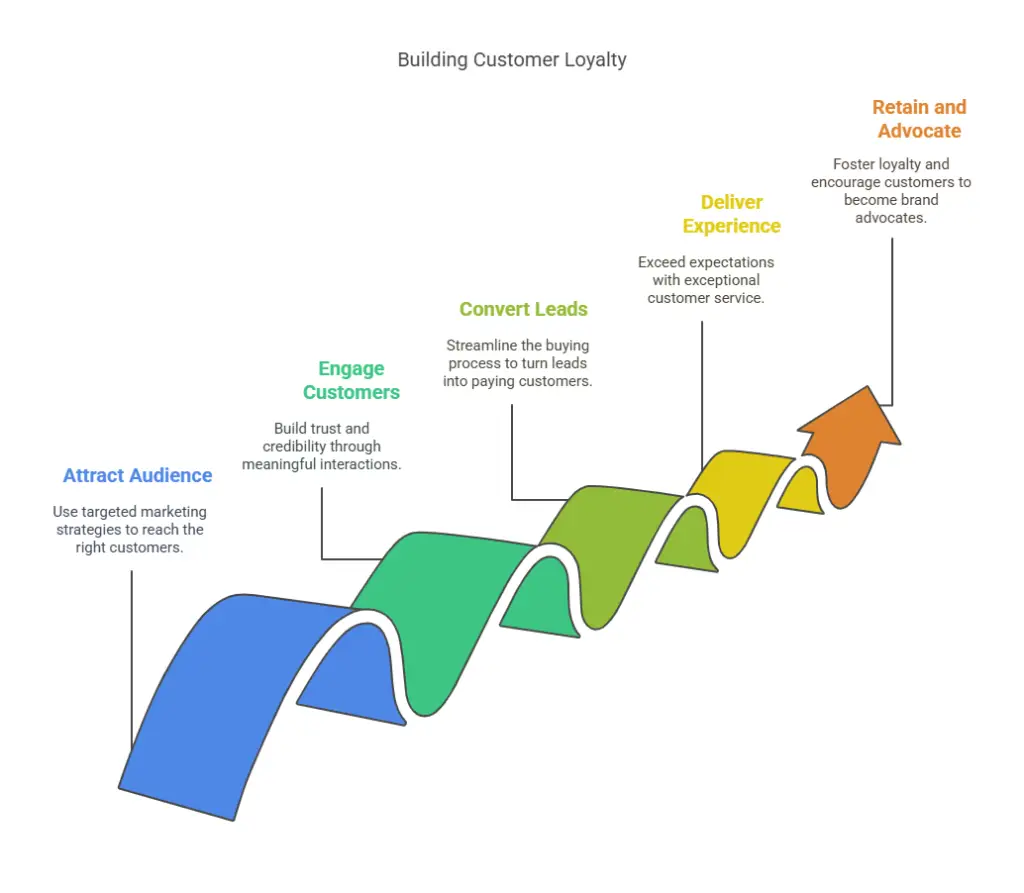
Why It Matters for Small Businesses
For small business owners, the Customer Value Chain is a game-changer because it helps:
✅ Increase Customer Retention – Research shows that acquiring a new customer costs five times more than retaining an existing one. A well-structured Customer Value Chain ensures that customers stay engaged and continue doing business with you.
✅ Build a Competitive Advantage – Businesses that optimize their entire customer journey outperform competitors who focus solely on lead generation. Customers are more likely to choose brands that provide a seamless, value-driven experience.
✅ Maximize Customer Lifetime Value (CLV) – By nurturing relationships beyond the initial sale, businesses increase the total revenue a customer generates over time. This leads to higher profits without constantly increasing marketing spend.
✅ Strengthen Brand Advocacy & Word-of-Mouth Referrals – Satisfied customers become your best marketers by recommending your business to others. According to Nielsen, 92% of consumers trust recommendations from friends and family over any other form of advertising.
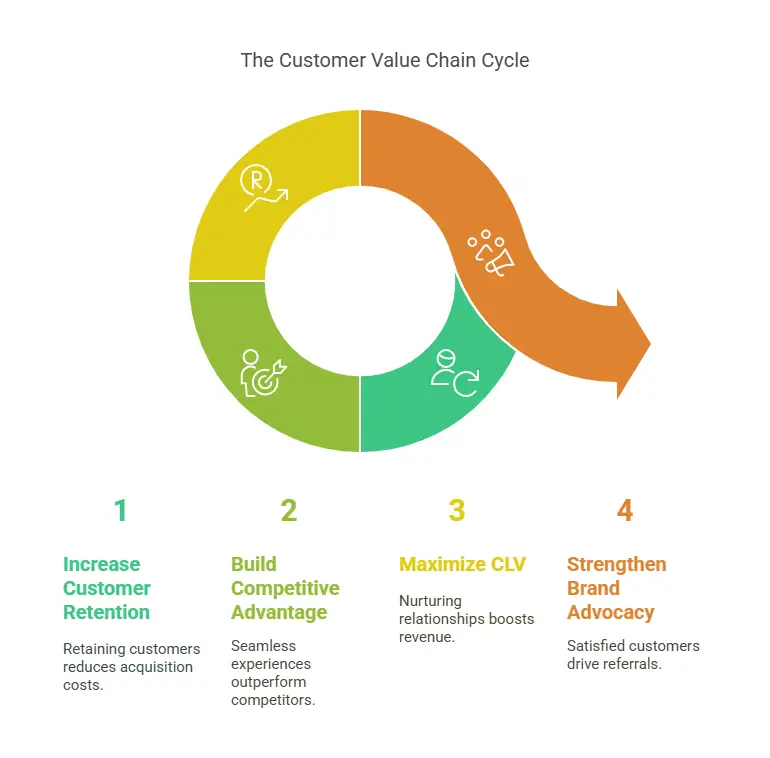
Customer Value Chain vs. Traditional Sales Funnels
📌 Focus:
- Customer Value Chain: Long-term relationship building
- Traditional Sales Funnel: One-time conversions
📌 Approach:
- Customer Value Chain: Continuous value delivery
- Traditional Sales Funnel: Linear, transactional
📌 Retention Strategy:
- Customer Value Chain: Prioritizes engagement & advocacy
- Traditional Sales Funnel: Ends after the sale
📌 Business Impact:
- Customer Value Chain: Sustainable growth, lower churn
- Traditional Sales Funnel: High churn, inconsistent revenue
Unlike traditional funnels, which often lose potential revenue after the sale, the Customer Value Chain extends beyond conversion, ensuring that businesses retain and maximize the value of every customer interaction.
The Customer Value Chain is not just a marketing tactic—it’s a business strategy that allows small businesses to thrive in competitive markets by focusing on value, retention, and long-term customer relationships.
In the next section, we’ll explore the 5 key stages of the Customer Value Chain and how you can optimize each one for maximum growth and profitability.
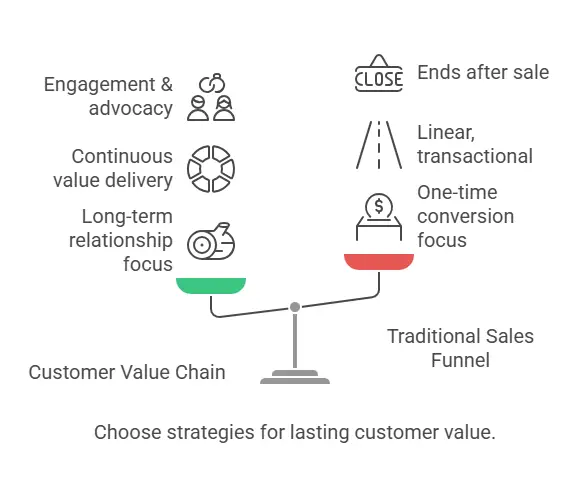
The 5 Key Stages of the Customer Value Chain
The Customer Value Chain consists of five key stages that guide potential customers from awareness to long-term brand loyalty. Each stage plays a crucial role in shaping the customer experience, and optimizing them ensures higher retention, stronger brand advocacy, and increased lifetime value (LTV).
Let’s break down each stage and how small businesses can maximize their effectiveness.
1. Attract: Drawing in the Right Customers
Goal:
Get the attention of potential customers who align with your ideal audience.
Key Strategies to Implement:
✅ SEO & Content Marketing – Optimize your website with relevant keywords and valuable blog content to drive organic traffic from Google.
✅ Social Media Marketing – Engage with your target audience on platforms like Instagram, LinkedIn, and Facebook by sharing valuable content and interacting with users.
✅ Paid Advertising – Use targeted PPC (Pay-Per-Click) campaigns on Google Ads and social media to reach high-intent buyers.
✅ Referral Programs – Encourage existing customers to refer new leads by offering incentives like discounts or freebies.
Common Mistakes to Avoid:
🚫 Trying to attract everyone instead of focusing on a specific target audience.
🚫 Ignoring data and analytics, leading to wasted marketing spend.
🚫 Using generic messaging that fails to resonate with the intended audience.
Action Tip:
✔ Use Google Analytics and heatmaps to identify your highest-performing traffic sources and double down on them.
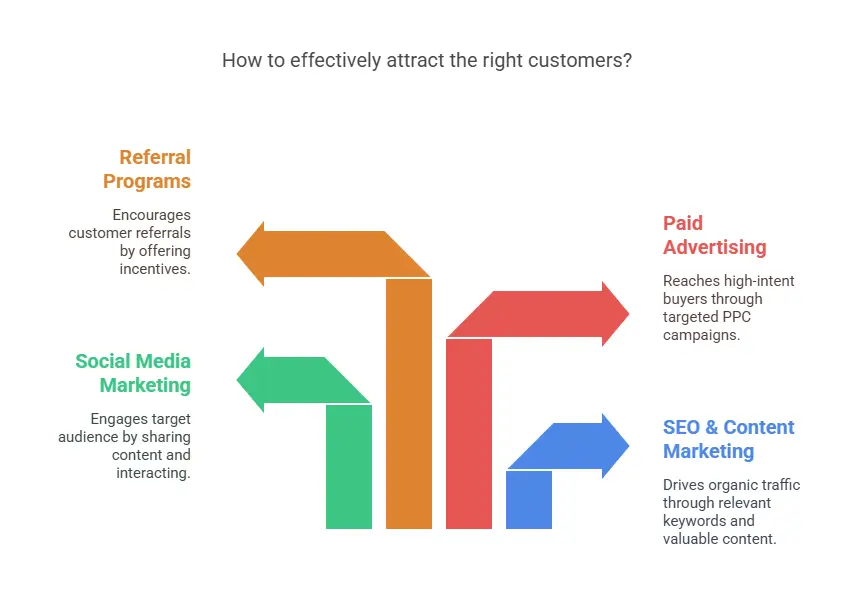
2. Engage: Building Trust & Relationships
Goal:
Move potential customers from awareness to consideration by fostering trust and engagement.
Key Strategies to Implement:
✅ Email Marketing Sequences – Set up automated email nurture campaigns that provide value before making a sales pitch.
✅ Personalized Customer Interactions – Use AI chatbots, live chat, and interactive content to answer questions in real time.
✅ Lead Magnets & Free Resources – Offer guides, webinars, or trials in exchange for contact information to build relationships.
✅ Social Proof – Showcase testimonials, case studies, and user-generated content to reinforce trust.
Common Mistakes to Avoid:
🚫 Being too aggressive with sales pitches before building trust.
🚫 Not following up with leads who show interest in your business.
🚫 Failing to personalize interactions, making prospects feel like just another number.
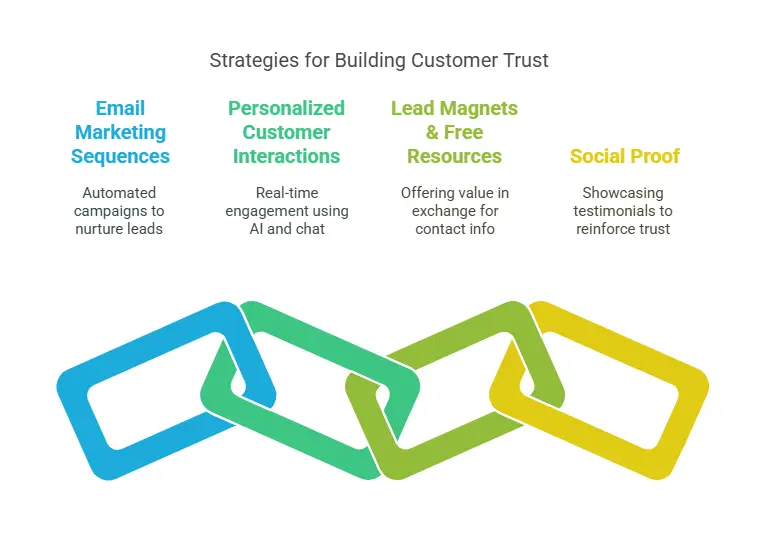
Action Tip:
✔ Use an email automation tool like Mailchimp or ConvertKit to nurture leads effectively over time.
3. Convert: Turning Prospects into Paying Customers
Goal:
Encourage potential customers to take action—whether it’s purchasing, signing up, or booking a service.
Key Strategies to Implement:
✅ Simplified Checkout Process – Reduce friction with one-click purchases, guest checkout options, and mobile-friendly payment solutions.
✅ Limited-Time Offers & Urgency – Use psychological triggers like scarcity, countdown timers, and flash sales to drive conversions.
✅ Money-Back Guarantee & Risk Reversal – Reduce hesitation with clear refund policies.
✅ Effective Calls-to-Action (CTAs) – Use direct and persuasive language to drive action (e.g., “Get Started Now” instead of “Submit”).
Common Mistakes to Avoid:
🚫 Having a complicated checkout process, leading to high cart abandonment.
🚫 Lacking clear pricing and benefits, making customers hesitant.
🚫 Failing to follow up on abandoned carts to recover lost sales.
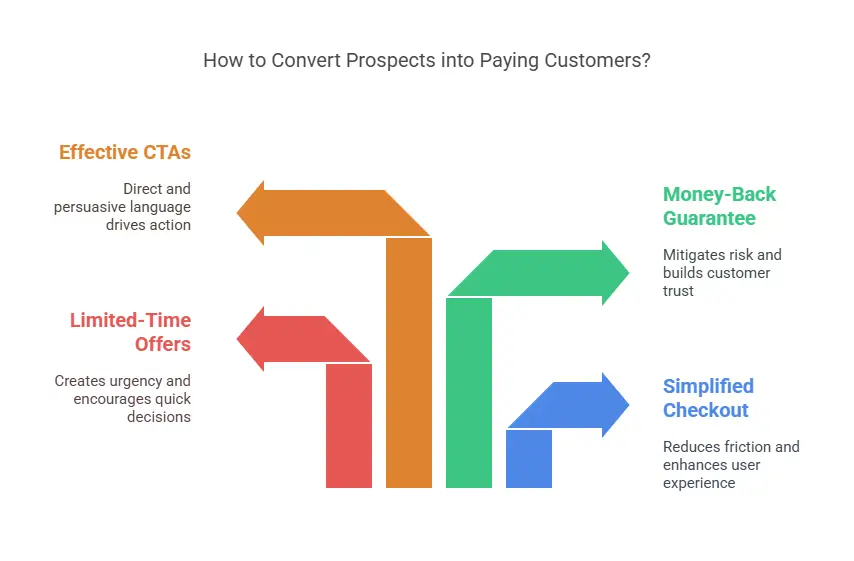
Action Tip:
✔ A/B test different CTAs, landing pages, and pricing models to see which converts best.
4. Deliver: Creating a Seamless Customer Experience
Goal:
Ensure the customer is satisfied after their purchase, leading to a stronger relationship.
Key Strategies to Implement:
✅ Fast & Reliable Delivery (For Products) – Optimize shipping processes and provide order tracking.
✅ Onboarding & Training (For Services) – Offer step-by-step guides, tutorials, or welcome emails to help customers get started.
✅ Customer Support Excellence – Provide multiple support options (live chat, email, phone) and respond quickly to inquiries.
✅ Surprise & Delight Strategy – Add unexpected value, such as handwritten thank-you notes or bonus perks.
Common Mistakes to Avoid:
🚫 Ignoring post-purchase engagement, leading to customer dissatisfaction.
🚫 Overpromising and underdelivering, damaging trust.
🚫 Not collecting customer feedback, missing opportunities for improvement.
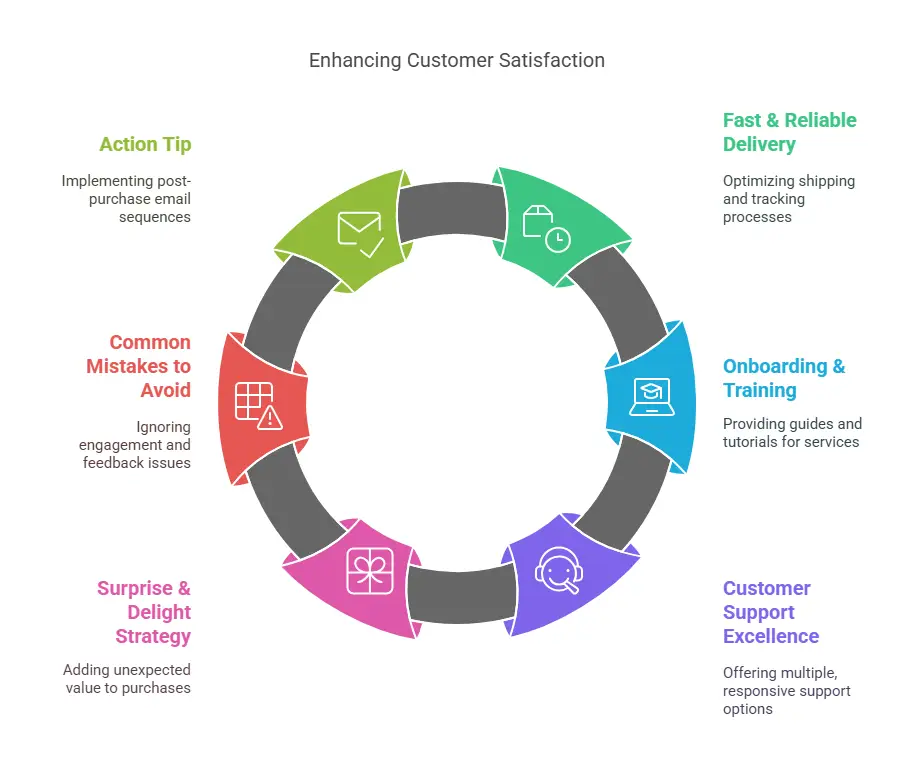
Action Tip:
✔ Implement a post-purchase email sequence that provides guidance and encourages feedback.
5. Retain & Advocate: Turning Customers into Brand Ambassadors
Goal:
Encourage repeat purchases and create loyal customers who promote your business to others.
Key Strategies to Implement:
✅ Loyalty Programs & Exclusive Discounts – Reward repeat customers with perks, early access, or special offers.
✅ Customer Engagement on Social Media – Reshare user-generated content and feature loyal customers.
✅ Referral & Affiliate Programs – Offer incentives for customers to refer new clients.
✅ Consistent Follow-Ups – Stay connected with past customers through personalized recommendations and engagement emails.
Common Mistakes to Avoid:
🚫 Assuming customers will stay loyal without ongoing engagement.
🚫 Failing to ask for reviews or testimonials, missing social proof opportunities.
🚫 Treating customer retention as an afterthought, rather than a core business strategy.
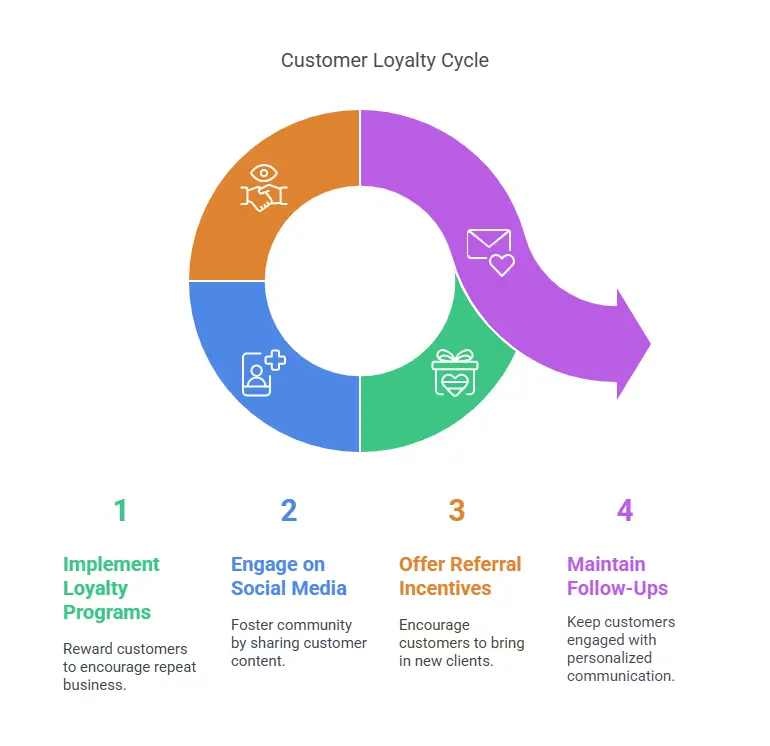
Action Tip:
✔ Create an automated re-engagement email that reaches past customers at 30, 60, or 90 days to encourage repeat business.
Key Takeaway: How to Make the Customer Value Chain Work for You
Each stage of the Customer Value Chain plays a vital role in business growth and customer satisfaction. By optimizing each stage, small businesses can increase conversions, reduce churn, and create a loyal customer base that advocates for their brand.
In the next section, we’ll explore how to measure and optimize your Customer Value Chain using key performance indicators (KPIs) and data-driven strategies.
Measuring & Optimizing Your Customer Value Chain (500 Words)
Once you’ve implemented the Customer Value Chain, the next step is ensuring it’s performing at its best. Many small business owners make the mistake of setting up marketing and customer retention strategies but fail to track their effectiveness. Without measurement, it’s impossible to know what’s working and what needs improvement.
This section will cover the key performance indicators (KPIs) you should track and the best tools and techniques for optimizing each stage of the Customer Value Chain.
Key Metrics to Track
To improve your Customer Value Chain, you need data-driven insights. Here are the most important metrics to monitor for each stage:
Key Metrics to Track in the Customer Value Chain
🔹 Attract:
- Website Traffic: Measures brand visibility and content effectiveness.
- Lead Generation Rate: Tracks how well marketing campaigns convert visitors into leads.
🔹 Engage:
- Email Open & Click Rates: Evaluates how engaged potential customers are with your emails.
- Social Media Engagement: Indicates how well your content resonates with your audience.
🔹 Convert:
- Conversion Rate: Shows the percentage of leads that turn into paying customers.
- Cart Abandonment Rate: Helps identify friction in the purchase process.
🔹 Deliver:
- Customer Satisfaction Score (CSAT): Measures immediate satisfaction after a purchase.
- Net Promoter Score (NPS): Gauges long-term customer loyalty and likelihood to recommend.
🔹 Retain & Advocate:
- Customer Retention Rate: Determines how well you retain customers over time.
- Referral Rate: Measures how many new customers come from word-of-mouth.
Tracking these metrics ensures you identify weak points in your value chain and adjust accordingly.
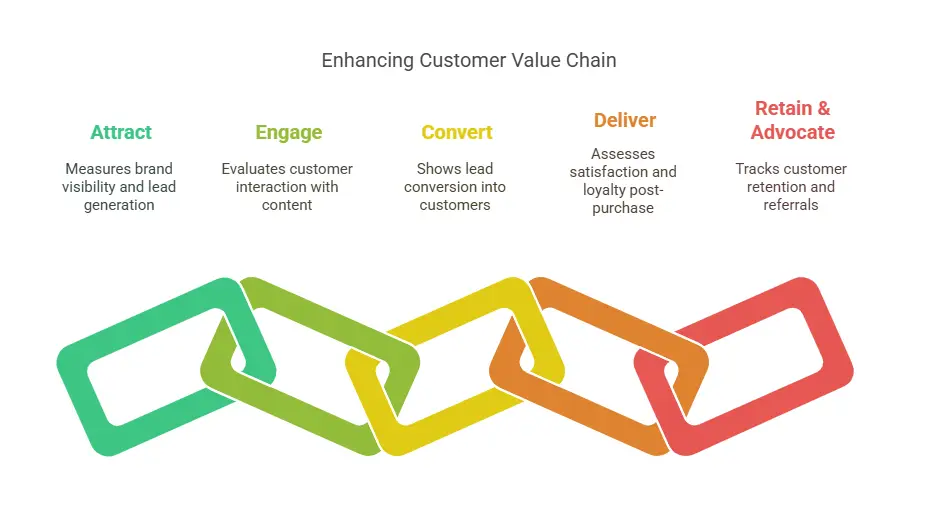
Tools & Techniques for Improvement
Once you’ve identified areas for improvement, use these optimization techniques and tools to refine your Customer Value Chain.
📍 Attract: Enhancing Visibility & Lead Generation
✔ Use Google Search Console & Google Analytics – Find out which pages drive the most traffic and optimize them further.
✔ A/B Test Paid Ads – Run multiple versions of ads to see which messaging or design resonates most.
✔ Improve SEO & Content Marketing – Update blog posts with fresh insights and keyword optimization to rank higher.
🚀 Action Tip: Identify the top-performing content and double down on similar topics to increase organic reach.
📍 Engage: Strengthening Customer Relationships
✔ Automate Lead Nurturing – Use email tools like Mailchimp or ConvertKit to personalize email sequences.
✔ Leverage Retargeting Ads – Show ads to website visitors who haven’t converted yet, reinforcing your brand.
✔ Optimize Social Media Strategy – Post consistently and engage with followers to increase trust and credibility.
🚀 Action Tip: Use social listening tools (like Hootsuite or Brandwatch) to monitor customer conversations about your brand.
📍 Convert: Increasing Sales & Reducing Drop-Offs
✔ Simplify the Checkout Process – Reduce form fields, enable guest checkout, and offer multiple payment options.
✔ Add Urgency & Scarcity – Limited-time offers and countdown timers encourage faster decisions.
✔ Offer a Risk-Free Guarantee – A money-back guarantee or trial period reduces purchase hesitation.
🚀 Action Tip: Implement an exit-intent popup with a discount or lead magnet for users who try to leave your sales page.
📍 Deliver: Enhancing the Customer Experience
✔ Set Up an Automated Onboarding Process – Use tools like Loom or video tutorials to make sure customers know how to use your product/service.
✔ Optimize Customer Support – Use AI chatbots for instant responses and live chat for personalized help.
✔ Send a Personalized Thank-You – Small gestures like a handwritten note or exclusive discount can enhance loyalty.
🚀 Action Tip: Set up customer feedback surveys (Google Forms, Typeform) to identify pain points in post-purchase experience.
📍 Retain & Advocate: Turning Customers Into Brand Ambassadors
✔ Launch a Loyalty Program – Reward repeat purchases with points or VIP discounts.
✔ Encourage Reviews & Testimonials – Use platforms like Trustpilot, Google Reviews, or Yelp to build credibility.
✔ Start a Referral Program – Incentivize existing customers to bring in new ones with rewards.
🚀 Action Tip: Send a personalized email to repeat customers thanking them and offering a special reward.
The Continuous Optimization Mindset
The Customer Value Chain is not a one-time setup—it requires continuous monitoring and refinement.
✅ Monthly Checklist for Optimization:
✔ Check Google Analytics to see where your traffic is coming from and improve weak areas.
✔ Review customer feedback and NPS scores to identify service improvements.
✔ Track conversion rates and cart abandonment rates to spot checkout friction.
✔ Evaluate email open rates and social engagement to fine-tune content.
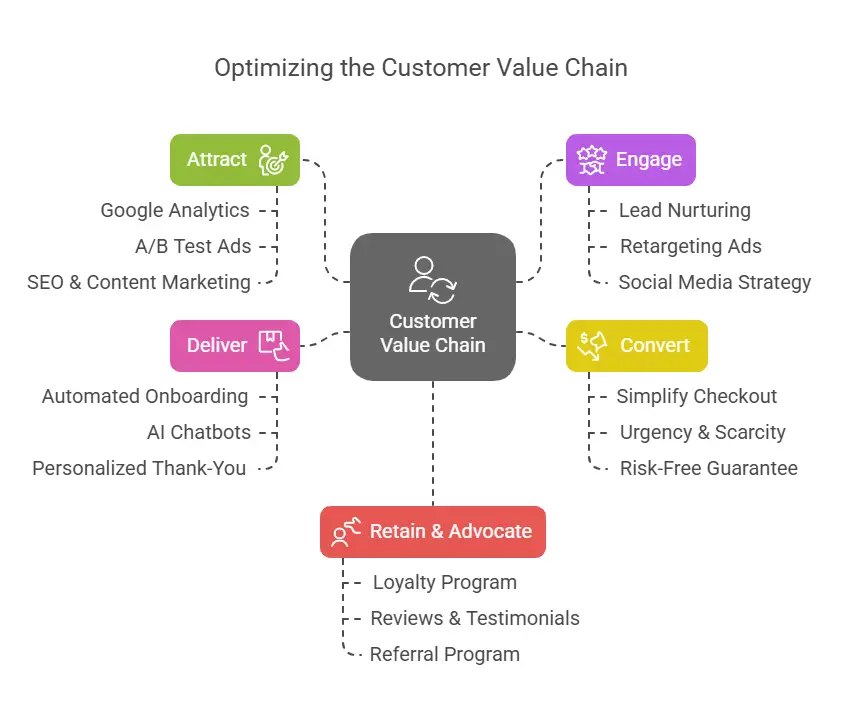
By consistently measuring and optimizing each stage, you’ll create a high-performing Customer Value Chain that drives more revenue, builds stronger customer relationships, and ensures long-term business success
Conclusion: Mastering the Customer Value Chain for Long-Term Business Growth
The Customer Value Chain isn’t just another marketing concept—it’s a powerful business strategy that helps small business owners attract, engage, convert, retain, and turn customers into loyal advocates. By understanding and optimizing each stage, you can create a sustainable, high-growth business that thrives in competitive markets.
🔹 Key Takeaways from This Guide:
✅ The Customer Value Chain is a holistic strategy that focuses on long-term customer relationships, not just quick sales.
✅ There are five essential stages—Attract, Engage, Convert, Deliver, and Retain & Advocate—each requiring targeted strategies to maximize customer lifetime value.
✅ Measuring success is crucial—tracking KPIs like customer retention, conversion rates, and NPS helps identify areas for improvement.
✅ Continuous optimization is key—using tools like Google Analytics, A/B testing, email marketing automation, and customer feedback surveys ensures sustained success.
By implementing these strategies, you’ll not only improve customer experience and retention but also drive higher revenue and brand loyalty.
🚀 Your Next Steps:
Now that you understand the Customer Value Chain, it’s time to take action:
✅ Audit Your Current Customer Journey – Identify which stage of the value chain needs improvement.
✅ Implement One New Strategy – Whether it’s improving lead nurturing, optimizing checkout, or launching a referral program, start with one key change.
✅ Track Your Progress – Use the recommended KPIs to measure impact and adjust as needed.
Want more insights on business strategy and customer psychology? Explore our latest guides on customer retention and conversion optimization to keep refining your approach! 🚀
Frequently Asked Questions
What is a customer value chain in business strategy?
A customer value chain is the full range of activities a company performs to create value for customers—from product development and marketing to delivery and after-sales service—aimed at maximizing satisfaction and building long-term loyalty.
What are the key components of a customer value chain?
The core components include inbound logistics, operations, outbound logistics, marketing and sales, and after-sales service. Each element contributes to delivering a seamless and valuable experience to the end customer.
Why is optimizing the customer value chain important?
Optimizing the customer value chain helps businesses reduce inefficiencies, cut costs, improve product quality, and enhance customer satisfaction. This leads to stronger competitiveness and higher overall business performance.
How does technology impact the customer value chain?
Technology improves the customer value chain by automating tasks, enabling better data analysis, and enhancing communication. These advancements help streamline operations and deliver more personalized and efficient customer experiences.
How can businesses evaluate the success of their customer value chain?
Companies assess success by tracking customer satisfaction, retention rates, and profitability. Regular analysis helps identify performance gaps and areas for improvement to ensure continuous value creation.
Further reading
Emilia Korczynska, “Customer Value Chain: How to Use It to Drive Product Growth,” Userpilot Blog, last modified January 18, 2024, https://userpilot.com/blog/customer-value-chain/.
Ashley King, “What Is a Customer Value Chain? And Why It’s the Key to Success,” Gladly Blog, last modified April 20, 2023, https://www.gladly.com/blog/customer-value-chain/.
Adam Greco, “Why Product Development Strategy Is More Important Than You Think,” Amplitude Blog, last modified June 5, 2023, https://amplitude.com/blog/product-development-strategy.
Will Kenton, “Value Chain,” Investopedia, last modified April 17, 2023, https://www.investopedia.com/terms/v/valuechain.asp.
Valuer, “The Value Chain Explained,” YouTube, uploaded September 13, 2021, https://www.youtube.com/watch?v=8gPXa9Lwovw.
Prof. Sambit Dash, “Value Chain Analysis | Value Chain Model | Michael Porter | Strategic Management,” YouTube, uploaded July 25, 2021, https://www.youtube.com/watch?v=JmTWhbnY_7g.
Two Teachers, “Value Chain – A Level Business,” YouTube, uploaded February 3, 2022, https://www.youtube.com/watch?v=rzU9BHA19yc.







